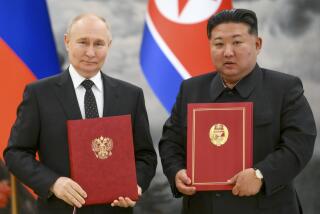TUMULTUOUS TIMES FOR WORLD TRADE : Japan-U.S. Pact: Gentlemen, Start Your Interpretations : Trade: Agreement on autos is a vague document. Already, there’s confusion and skepticism on both sides of the Pacific.
As U.S. and Japanese negotiators were announcing their hard-fought agreement on auto trade this week, Nissan North America was unveiling a global business plan that includes a provision to shift $30 million worth of parts purchases from Japan to a small company named Daikin Clutch Corp. in Belleville, Mich., sometime next year.
As far as Nissan is concerned, that helps to satisfy its commitment to buy American. Daikin is situated in America, employs Americans and pays American taxes.
But it is a subsidiary of a Japanese firm. And U.S. auto parts executives argue that the whole point of the contentious two-year battle over U.S. access to the Japanese automobile market, that what nearly led the two nations into a trade war, was to boost business for U.S.-owned companies, not Japanese transplants such as Daikin.
This disagreement over the meaning of the Japanese auto industry’s pledges to increase their “local procurement” of U.S. parts and supplies highlights a weakness in a trade agreement whose vagueness is prompting confusion and skepticism on both sides of the Pacific Ocean.
The chameleon-like quality of this agreement--which is being described as a victory by both the Japanese and the Americans--had both sides scrambling Thursday to try to assess the real meaning of what was described by President Clinton as “a major step toward free trade throughout the world.”
Although it seems likely that U.S. parts makers and auto makers will indeed get more business as a result of the deal, there also appears to be plenty of room for mischief.
In Japan on Thursday, TV commentators were cracking jokes about the ambiguities in the agreement, and other critics were saying the pact defies analysis.
The auto agreement amounts to “a new form of tamamushi-iro [iridescent] compromise,” the color of which changes depending on the eye of the viewer, Tetsuo Kondo, a former Economic Planning Agency director, told The Times.
U.S. auto parts suppliers were at first believed to be the biggest winners, since Japanese manufacturers had pledged to dramatically increase their purchases of U.S. auto parts. But it is unclear just how big the U.S. share will be.
Japanese auto makers that began building cars in the United States in the 1980s have always used a high percentage of parts purchased from affiliates in Japan or subsidiaries that followed them here. But purchase of U.S. parts has increased as the value of the yen soared in recent years and the Japanese auto producers, under U.S. pressure, deliberately sought out U.S.-based suppliers.
The agreement reached this week in Geneva is designed to speed that trend while also increasing the number of Japanese dealerships carrying American cars and loosening Japanese government restrictions that discourage the use of U.S. parts in Japan.
Dana Corp. of Toledo, Ohio, is the largest U.S. supplier of auto parts to Japanese transplants, yet it has managed to obtain only a tiny piece of the Japanese market after 30 years of trying. But Dana is convinced that the Clinton Administration’s threat of trade sanctions created opportunities for U.S. companies that wouldn’t have existed otherwise.
“Some of this would’ve happened anyway [because of the high cost of the yen], but I’d hope that this has a way of speeding it up,” Dana spokesman Gary Corrigan said.
As part of this week’s agreement, the Office of the Trade Representative said it expects Japanese auto makers to buy nearly $9 billion more in parts from U.S. suppliers by 1998--up 50%--for use both in Japan and the United States.
But Nissan and other Japanese auto makers said those business plans are projections that could change depending on the economy, and that there is no guarantee that the stepped-up purchases will come from U.S.-based companies.
That comes as a rude surprise to the U.S. auto parts industry.
Barbara Posner, a spokeswoman for Illinois-based Tenneco Automotive, one of the world’s largest suppliers of shock absorbers and mufflers, said it was her understanding that U.S. companies would be the primary beneficiaries of any increased Japanese purchases.
John Reilly, a spokesman for the U.S. Automotive Parts & Accessories Assn., saw it that way too. But he acknowledged that there seems to be a rather large gulf between the two sides on exactly what the agreement means.
“We are hoping that can be clarified next week,”he said.
Does it make any difference where the jobs come from? The Japanese argue that all companies operating in the United States support the U.S. economy regardless of the national origin of the parent company.
But U.S. auto industry representatives and union leaders--who have had little luck organizing workers at the Japanese-owned plants--argue that the jobs tend to pay lower wages and provide fewer benefits. Moreover, profits earned by such operations ultimately strengthen the Japanese parent companies, not U.S. companies. And the transplant factories themselves draw heavily on Japanese components, undercutting the goal of trimming the U.S. trade deficit with Japan.
Ultimately, the success of the agreement will be measured by what change occurs in Japan’s long-restricted market. And there, analysts suggested that the long-term dynamics may indeed shift toward some opening of the market to foreign goods, greater efforts by Detroit’s Big Three to step in, and fewer exports of finished Japanese cars.
Tetsuo Kondo, a former director of the Japanese cabinet’s Economic Planning Agency, said he believes that both the Ministry of International Trade and Industry and the auto industry realize privately that “they will have to work toward the goals that [U.S. Trade Representative Mickey] Kantor announced. They know if they don’t, the problem will arise again.”
Among the more easily measurable outcomes, the agreement should help ease access of foreign manufacturers to Japanese dealerships. The Japan Automobile Dealers Assn. pledged Thursday to help foreign manufacturers locate dealers in Japan to sell their cars.
The association also released a list of 58 dealers expressing interest in entering into franchise agreements with foreign auto makers. It also announced it would establish an office to hear complaints from foreign car makers about problems they encounter in Japan.
But the main impetus for expanding the number of dealers in Japan carrying U.S. cars is likely to come from Detroit. Earlier this week, Chrysler Corp. announced a major expansion of its presence in Japan, predicated partly on the assumption that the trade talks would succeed in producing easier access to Japanese-owned dealerships.
Yet Ford Motor Co., the most aggressive of the U.S. firms in Japan, indicated that nothing in the agreements signed in Geneva seems likely to be of great help in expanding its dealership network.
“The point is whether dealers make their own business decisions, without [needing] permission or being under control of the manufacturers,” said Hiro Tanabe, a spokesman for Ford Motor Co. (Japan) Ltd. “We are not sure if these actions [announced Wednesday] will help the dealers make their own decisions. This is the question.”
Meanwhile, skepticism in the United States about how the parts-purchase agreement will be implemented was borne out by remarks from Masami Iwasaki, chairman of the Japan Automobile Manufacturers Assn.
Responding to political criticism of possible job losses in Japan arising from the agreement, Iwasaki said that “some of the parts for the cars assembled overseas will be manufactured at home, increasing production here. Therefore, I don’t think production at home will decline exactly as production overseas increases.”
*
Iritani reported from Los Angeles and Holley from Tokyo. Staff writer Sam Jameson in Tokyo contributed to this article.
* TRADE STALEMATE
Talks near collapse on opening financial services sector. D3.






